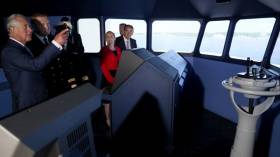Displaying items by tag: Irish Naval Base
#NavyNews - On visit to Cork Harbour writes the Irish Examiner, the Prince of Wales discovered that piloting a ship is like riding a bike – you never lose the knack.
More than 40 years after he commanded a British warship during his Royal Navy days he returned to the bridge – albeit a simulator with a very realistic 180-degree projection of the sea.
Charles, who captained the mine hunter HMS Bronington for 10 months in 1976, joined naval students at the National Maritime College of Ireland (NMCI) near Cork for the trip down memory lane.
At first, Lieutenant Gavin McCarthy, a navigation instructor, called out the manoeuvres for the ship WB Yeats which Charles repeated for those training for a career on the seas.
WB Yeats – a mock-up of a real off-shore patrol vessel – was in waters off the town of Cobh, famous for being the last port of call for the Titanic before it set off on its ill-fated journey.
Charles marvelled at the scene in front of him which gave a real-time feel to the movement of the ship, especially when stormy waters were introduced with the click of a mouse and he said “it’s extraordinary” as the projection outside the windows appeared to make the ship move up and down over the waves.
For further reading of the historic visit to the naval base, click here.






























































